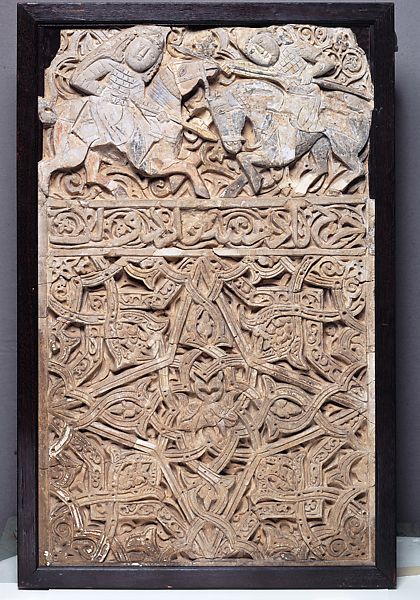Cavalry and a Star on a 12th century Seljuk Bas Relief

A larger image of the Cavalry on this 12th century Seljuk Bas Relief, Art Museum, Seattle
Picture source: metmuseum

RELIEF WITH TWO FIGHTING HORSEMEN, STAR MEDALLION
12TH - 13TH CENTURY
PERSIAN
Stucco, 43 1/8 x 19 3/4 in. (109.5 x 50.2 cm)
Eugene Fuller Memorial Collection, 54.29
Provenance: Formerly in possession of [Demotte, New York and Paris, prior to 1938], when published in Pope; (unknown, 1938-1945); in possession of [Demotte, New York and Paris, 1945], when published in Pope; (unknown, 1945-1954); [Heeramaneck Galleries, New York, 1954]; purchased from gallery by the Seattle Art Museum, 1954
Seattle Art Museum
Stucco plaque showing armoured cavalrymen jousting or in combat, Iran 12th-13th centuries. The two men are very similarly equipped, both having a small form of jawshan lamellar cuirass over their chests. However the horseman on the left also has a long cloth over his pointed hat or more probably helmet. This is given to elite guard figures or courtiers in other sources, and perhaps serves the same function here.
(inv. 54.29, Art Museum, Seattle, USA). Source: p54, EH - 001 - Essential Histories. The Crusades. by David Nicolle
Another representation of this subject occurs on a well known twelfth century stucco panel from Iran, now in the Seattle Art Museum (fig. 26)48. It again shows a combat of two lancers, depicted in its upper register, and a pair of peacocks with intertwined and colliding beaks in the central medallion. The precise origin of this panel is not known. Yet one is probably not wrong by regarding it as remains of a wall decoration of a Saljuq palace or summer residence. As for the peacocks, we have just seen that the same motif is also shown at the opposite end of the frieze from JŠtiva, a coincidence which may not be accidental. Variations of the jousting scene, though rendered in a different, much more static style, occur again in two medallions on the Spanish Umayyad ivory casket from Pamplona which, in addition, depicts on its front a seated dignitary flanked by two attendants as well as other activities associated with princely pastime49.
Source: The 'Pila' of JŠtiva. A Document of Secular Urban Art in Western Islam by Eva Baer in Kvnst des Orients Vol. 7, H. 2 (1970/71), pp. 142-166.
Referenced on p3, Byzantine Armies AD 1118-1461 by Ian Heath & Angus McBride:
Seljuk horsemen of the 12th-century in light armour comprising helmet and lamellar corselet. Note that the lance is wielded two-handed. Though the majority of Seljuks in Byzantine service were horse-archers some are known to have been armoured.
Referenced on p21, God's Warriors, Knights Templar, Saracens and the Battle for Jerusalem by Helen Nicholson & David Nicolle:
Late 12th- to early 13th-century stucco relief from Persia showing horsemen fighting with spears held in both hands. They wear lamellar jawshan (cuirasses), which on the right has flaps to protect the upper arms.
Referenced as figure 385 in The military technology of classical Islam by D Nicolle
385. Stucco relief from Rayy (?), 12th-13th centuries AD, Iranian, Art Museum, Seattle (Pope).
p174 Lamellar armour may also have been used in Byzantium in the pre-Islamic era39 (Figs. 90, 91 and 556) but its more widespread adoption after the 7th century clearly reflected Muslim military pressure40 (Figs. 212, 220A, 314, 630 and 637). A smaller but equally common kabadion lamellar cuirass was seen in Byzantium from the 10th century41 (Figs. 227, 242, 249, 314, 414 and 608). This could reflect the changing fashions of eastern Islam, where the lamellar kamaband may have been developed in the 10th century, or it could have been the Byzantine original that stimulated the adoption of this latter Iranian form of armour (Figs. 209, 241, 292, 294, 306, 347, 354, 376, 377, 385, 390, 392, 422, 446, 447 and 641).
39. Haldon, "Some Aspects of Byzantine Military Technology from the 6th to the 10th centuries," p. 20.
40. Ibid., pp. 25-26,29 and 46.
41. Ibid., p 36.